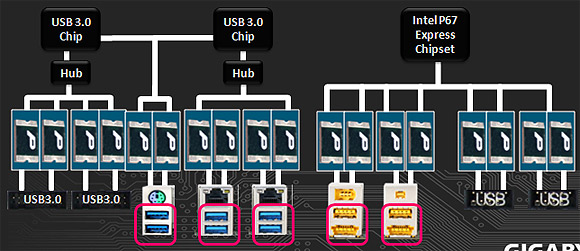The Gigabyte GA-P67A-UD7-B3 motherboard draws its USB 3.0 from a combination
of sources; the Intel P67 chipset and two VLI VL810 hubs / NEC Renesas D720200
controllers. There is a mode in the BIOS called "Tubro USB 3.0" which if
activated enables the second NEC Renesas D720200 controller to switch to a
direct connection with the Intel socket 1155 processor, essentially
circumventing the Intel P67 chipset.
If this is done several USB 3.0 ports will end up sharing bandwidth with the PCI Express x8 lanes devoted to
the videocards, so unfortunately that means if you want to use the USB
3.0 ports in this mode you will be restricted to a single videocard operating in PCI Express
x8 mode if we understand the manual correctly.
Gigabyte has also increased the amount of power supplied by the
USB ports, so devices like an Apple iPad can be recharged. Standard USB 2.0
ports are limited to 500mA maximum load and the USB 3.0 specification increases
this to 900mA. On the Gigabyte GA-P67A-UD7-B3 motherboard these values are
increased to a maximum of 1500mA for USB 2.0, 2700mA for USB 3.0 ports.
In addition the fusing behind each USB port has been improved. Traditional
fusing typically reduces available power from the nominal 5V, to 4.6V.
|

Each USB
port is protected by a solid-state fuse, that according to Gigabyte is 4X
more power efficient.
|
Solid state fuses like the ones pictures above are
standard to all recent motherboards and you'll find them near every USB
or Firewire port if you look. Higher tolerance fuses are installed on this platform so power drop
is reduced to 4.8V we are told, rather than 4.6V. USB voltage levels can
impact device stability and the number of devices able to be connected to each
port.
Additionally, one USB header is designed to continue
to receive power even when the PC system is
powered off, so iPad/iPod/iPhones/cellphones/MP3 players can be plugged in and charged up without having to
leave the rest of the computer on.
Overclocking features are represented in the Gigabyte GA-P67A-UD7-B3 BIOS as you
might expect. A brief look at the overclocking options is next.
